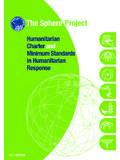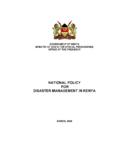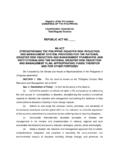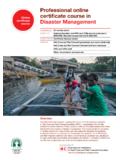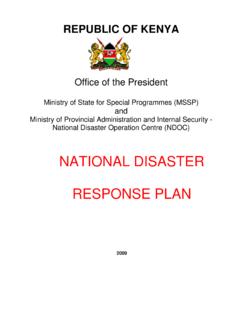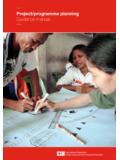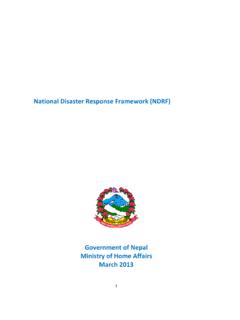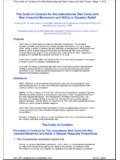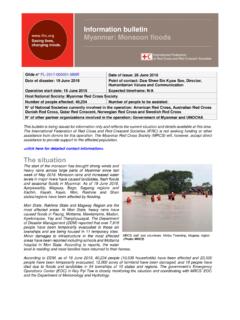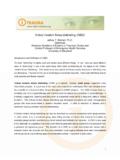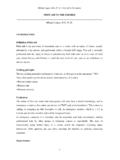Transcription of International first aid and resuscitation guidelines …
1 Lives, changing first aid and resuscitation guidelines 2016 For National Society first aid programme managers, scientific advisory groups, first aid instructors and first responders International Federation of Red Cross and Red Crescent Societies, Geneva, 2016 Copies of all or part of this study may be made for noncommercial use, providing the source is acknowledged The IFRC would appreci-ate receiving details of its use. Requests for commercial reproduction should be directed to the IFRC at opinions and recommendations expressed in this study do not necessarily represent the official policy of the IFRC or of individual National Red Cross or Red Crescent Societies. The designations and maps used do not imply the expression of any opinion on the part of the International Federation or National Societies concerning the legal status of a territory or of its authorities.
2 All photos used in this study are copyright of the IFRC unless otherwise indicated. Cover photo: American Red Box 303CH-1211 Geneva 19 SwitzerlandTelephone: +41 22 730 4222 Telefax: +41 22 733 0395E-mail: site: first aid and resuscitation guidelines 2016 1303500 05/2016 EFollow us on: International Federation of Red Cross and Red Crescent SocietiesInternational first aid and resuscitation guidelines 20161 International first aid and resuscitation guidelines 2016for National Society first aid programme managers, scientific advisory groups, first aid instructors and first respondersThe International Federation of Red Cross and Red Crescent Societies (IFRC) is the world s largest volunteer-based humanitarian network. With our 190 member National Red Cross and Red Crescent Societies worldwide, we are in every community reaching million people annually through long-term services and development programmes, as well as 110 million people through disaster response and early recovery programmes.
3 We act before, during and after disasters and health emergencies to meet the needs and improve the lives of vulnerable people. We do so with impartiality as to nationality, race, gender, religious beliefs, class and political opinions. Guided by Strategy 2020 our collective plan of action to tackle the major humanitarian and development challenges of this decade we are committed to saving lives and changing minds. Our strength lies in our volunteer network, our community-based expertise and our independence and neutrality. We work to improve humanitarian standards, as partners in development, and in response to disasters. We persuade decision-makers to act at all times in the interests of vulnerable people. The result: we enable healthy and safe communities, reduce vulnerabilities, strengthen resilience and foster a culture of peace around the Federation of Red Cross and Red Crescent SocietiesInternational first aid and resuscitation guidelines 2016 International Federation of Red Cross and Red Crescent SocietiesInternational first aid and resuscitation guidelines 20163 Table of contentsAcknowledgments 6 Foreword 8 Abbreviations 10 Introduction
4 11 About this document 12 Link to Strategy 2020 12 Where do the guidelines fit in IFRC policy? 13 Definition, trends and facts and figures 15 Definition of first aid 15 Progress and trends in first aid: community-based health and first aid in action 15 Number of people reached 16 Process to develop these guidelines 17 Summary of scientific foundation and guidelines 18 Local adaptation 20 Future development 20 General principles 21 Citizen preparedness for disasters and daily emergencies 21 Prevention 22 Personal safety 22 Linkages to other healthcare 23 Update and retraining 23 Target populations and their supporters 24 Ethics 24 Education 25 Introduction
5 25 What is effective first aid education? 28 Foundation for first aid education 29 The effectiveness of first aid education on casualty outcomes 32 Motivation of the learner 33 The effectiveness of using different learning modalities 34 Scenario-based and simulation learning 37 first aid education for children 38 Measuring outcomes 39 Conclusions 40 General approach 42 Introduction 42 Assessment 43 Casualty positioning 44 Call for help, EMS or further help 45 Medication administration 464 International Federation of Red Cross and Red Crescent SocietiesInternational first aid and resuscitation guidelines 2016 first aid for medical conditions 48 Allergic reaction and second dose of epinephrine for anaphylaxis 48 Poisoning 50 Breathing difficulties 54 Chest pain 55 Stroke 57 Dehydration and gastrointestinal distress 60 Seizures 63 Fever 64 Diabetes and hypoglycaemia treatment 66 Use of oxygen 68 Shock and optimal position for shock 69 Unresponsive and
6 Altered mental status 71 Fainting 72 Croup 72 first aid for injuries 74 Foreign body airway obstruction 74 Burns 79 Bleeding 81 Amputation 84 Concussion 84 Cervical spinal motion restriction 87 Chest and abdomen injuries 89 Extremity injuries 90 Wounds and abrasions 91 Dental avulsion 93 Injuries due to chemical exposure 94 Environmental health problems 97 Health problems caused by cold 97 Health problems caused by high altitude 100 Radiation emergencies 101 first aid for animal-related impairments 104 Animal bites 104 Snakebites 105 Jellyfish stings 107 Insect bites or stings 110 Drowning and scuba diving decompression illness 113 Drowning process 113 Cervical spine injury among drowning casualties 118 Scuba diving decompression illness 119 resuscitation 122 Introduction 122 Cardiac arrest 122
7 Early defibrillation 125 resuscitation in children 125 Withholding of resuscitation in cases of traumatic pre-hospital cardiopulmonary arrest 130 Methods of providing ventilation 131 International Federation of Red Cross and Red Crescent SocietiesInternational first aid and resuscitation guidelines 20165 psychological first aid 135 Introduction 135 psychological first aid principles 137De-escalating techniques for violent behaviour 138 Panic attack 140 Extreme stress and post-traumatic stress disorder 141 Suicidal ideation 143 References 145 Appendix 181 Appendix 1: Global survey data on first aid 181 Appendix 2: Summary table of topics revision 184 Note: Medical information changes constantly and therefore, should not be considered current, complete or exhaustive.
8 You should not rely on the information in these guidelines to recommend a course of treat-ment for yourself or any other individual; doing so is solely at your own guidelines provide general information for educational purposes only. They are not designed to and do not provide medical advice, professional diagnosis, opinion, treatment or services. They are not a sub-stitute for medical or professional care, and the information should not be used as an alternative to a visit, call, consultation or advice of a physician or other healthcare provider. The International Federation of Red Cross and Red Crescent Societies is not liable or responsible for any advice, course of treatment, diagnosis or any other information, services or product you obtain through these Federation of Red Cross and Red Crescent SocietiesInternational first aid and resuscitation guidelines 2016 AcknowledgmentsThe Steering Committee of the International Federation of Red Cross and Red Crescent Societies (IFRC) Evidence-Based Network: David Markenson, MD.
9 American Red Cross Philippe Vandekerckhove, MD .. PhD, Belgian Red Cross Pascal Cassan, MD .. IFRC Global first Aid Reference Centre The following team, in addition to the Steering Committee, has coordinated the Evidence-Based Network: Jeffrey L. Pellegrino, PhD, MPH .. American Red Cross Susanne Schunder-Tatzber, MD .. Austrian Red Cross Emmy De Buck, PhD, Centre for Evidence-Based Practice .. Belgian Red Cross Viv Armstrong, MD .. British Red Cross Emily Oliver .. British Red Cross Andrew MacPherson, MD .. Canadian Red Cross Daniel Meyran, MD .. French Red Cross Gabor G bl, MD .. Hungarian Red Cross The following IFRC team participated in the International Liaison Committee on resuscitation (ILCOR) process, which developed the first aid Consensus on Science: Richard Bradley, MD .. American Red Cross David Markenson, MD.
10 American Red Cross Jeffrey L. Pellegrino, PhD, MPH .. American Red Cross Linda Quan, MD .. American Red Cross Richard Rusk, MD, MPH .. American Red Cross S. Robert Seitz .. American Red Cross Nici Singletary, MD .. American Red Cross Christina Hafner, MD .. Austrian Red Cross Susanne Schunder-Tatzber, MD .. Austrian Red Cross Emmy De Buck, PhD, Centre for Evidence-Based Practice .. Belgian Red Cross Philippe Vandekerckhove, MD, PhD .. Belgian Red Cross Andrew MacPherson, MD .. Canadian Red Cross Gabor G bl, MD .. Hungarian Red Cross Pascal Cassan, MD .. IFRC Global first Aid Reference CentreThe following representatives from across the Red Cross Red Crescent Movement have participated in the work of the Evidence-Based Network either as members or contributors and/or in attending some of the meetings held to prepare the writing of these guidelines : Fitzmorris T.
